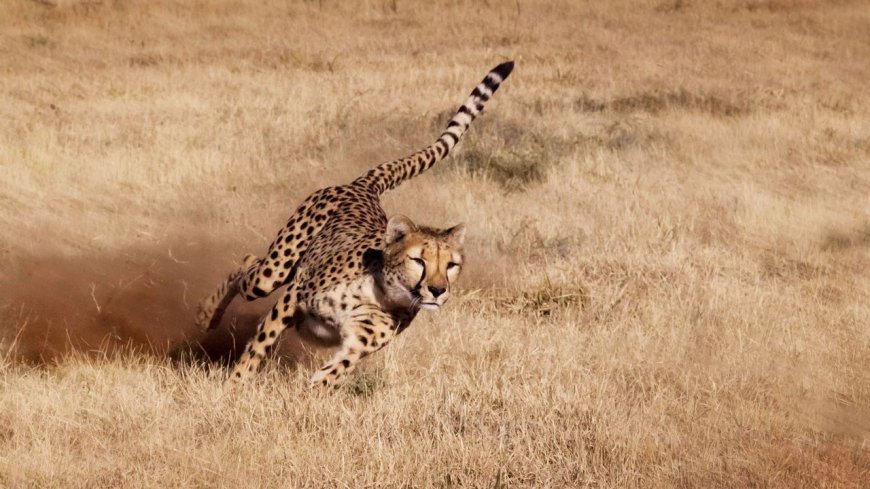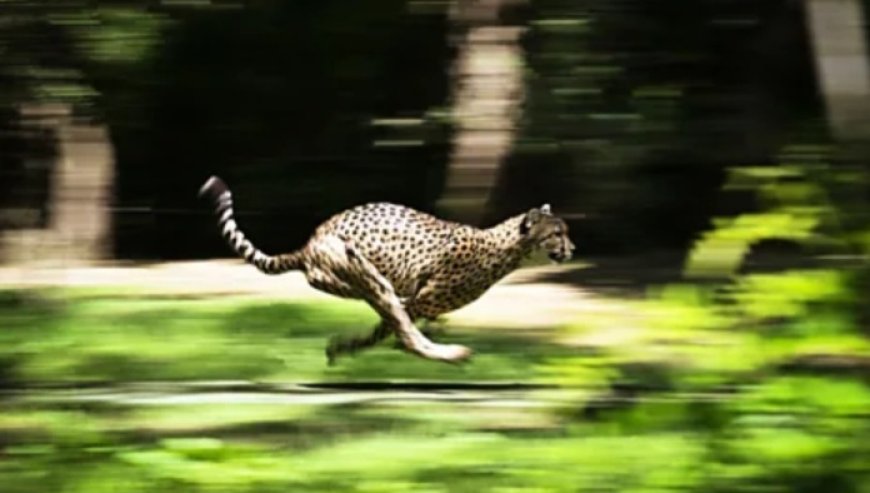What Olympic runners can learn from cheetahs

Cheetahs are famous for being the fastest land animals – but research suggests there's much more to their athleticism than just speed.
Imagine you are an impala, racing across the African savannah to try and escape a cheetah – the world's fastest land animal, which can reach a running speed of more than 100 km/h (62 mph). It may seem like a hopeless effort, but in real life, impalas do sometimes manage to get away. Which running strategy do you think would give you the best chance of beating the cheetah?
A. Fast and in a straight line
B. Fast and zig-zag
C. Slow and in a straight line
D. Slow and zig-zag
A growing body of research on wild cheetahs and their prey not only reveals the answer to this quiz – more on this below – but also offers wider insights into why exactly cheetahs are so fast, and what we might learn from them to help our own athletic pursuits.
Alan Wilson, a professor of locomotor biomechanics at the Royal Veterinary College, University of London, UK, and his team have revealed a nuanced picture of cheetahs' athleticism. They have used special tracking collars to measure their speed and movements. They have also filmed the animals from an aircraft, and performed biopsies of the muscles of dead cheetahs. One crucial finding, according to Wilson, is that their athletic performance is about much more than speed.
"You look at a cheetah and think, 'there's an animal that's evolved to be the ultimate high-speed athlete'," he says. "But it's not, it's evolved to be the ultimate manoeuvrer, and it happens to be fast."
In a 2013 study published in Nature, Wilson and his team equipped three female and two male adult cheetahs in Botswana with tracking collars to gather data on 367 runs over 17 months. Until that study, data on cheetahs' speed was from captive animals chasing a lure in a straight line, or, for wild cheetahs, from direct observation and film, according to the paper.
The data from the collars did confirm that cheetahs are incredibly fast: the highest recorded speed was 93 km/h (58 mph, or 25.9 m/s). By comparison, the top speed reached by a human is 12.32 m/s, which was achieved by Usain Bolt in the 2009 Berlin World Championships in Athletics. There's no doubt, then, that if cheetahs were to compete at the Paris Games this year, they would win gold. But Wilson and his team discovered that there's much more to cheetah fitness than speed.
In fact, most of the tracked hunts involved only moderate speeds – but featured a lot of manoeuvring, such as speeding up, slowing down, and sharply turning. The cheetahs, which mostly hunted impalas, accelerated and decelerated with twice the power of polo horses, and accelerated faster than greyhounds at the start of a race, according to the study. Their anatomy plays a key part in these feats, with their powerful back musculature helping them accelerate, for example.
"Cheetahs are muscular," Wilson points out. "People look at cheetahs in a zoo and see a sort of two-dimensional coat rack, but a wild cheetah doesn't look like that. A wild cheetah has quite a bit of muscle on it. They're much more substantial than a greyhound. They've got big legs, big shoulders, lots of powerful muscles – that's an important part of being an athletic animal."
These strong muscles are supported by other useful anatomical features that allow them to move forward from the ground very quickly, as well as turning, he adds. "They have a lot of grip, they have these non-retractable claws, like a set of running spikes." He sums up how all these elements come together when a cheetah hunts: "The muscles work quickly and powerfully so you can speed up and slow down, the legs are strong so you can apply big forces and redirect, and the body is versatile… it can twist and you can lean into a turn". Even the tail helps: the cheetah whips it from one side to the other to bank the body over, using the tail as a counterweight in sharp turns.

Cheetahs use their big legs and shoulders and powerful back muscles to quickly accelerate (Credit: Getty Images)
In a later study, published in 2018, Wilson and his team tracked the predator-prey dynamics in these hunts, by putting collars on cheetahs and impalas, and, in another pairing, lions and zebras.
They found that cheetahs and impalas were overall more athletic than lions and zebras in terms of speed, acceleration and turning, according to the data from five cheetahs, seven impalas, nine lions and seven zebras, tracked over hundreds of runs, as well as biopsies of dead animals. However, within each predator-prey pair, the predators were more athletic than their prey. Specifically, the predators had more powerful muscles and greater acceleration and deceleration capacity than their prey.
In the paper, the researchers pointed out that the predators' athletic superiority makes sense from an evolutionary point of view, and also reflects their general movement patterns, since predators hunt often, as they need to hunt to feed themselves, while prey are relatively rarely hunted. Wilson says that as a rule of thumb, impala and other prey face a roughly 50% chance of dying by a predator, and 50% of dying by other causes. (Studies on the causes of death of wild animals suggest these can vary a lot depending on the prey's age, environment, and the type of species; one wide-ranging study suggests predation causes 55% of deaths).
It therefore wouldn't be a good evolutionary strategy for an impala to only excel at outrunning cheetahs. "You can't just devote all your adaptations to be really good at running away, you have to be able to forage, you have to be able to fight, so there is that sort of balance," he says.
People look at cheetahs in a zoo and see a sort of two-dimensional coat rack, but a wild cheetah doesn't look like that – Alan Wilson
Meanwhile, for cheetahs, their legendary speed is only one of several athletic skills they need for hunting – but it just happens to be the one we as humans have most noticed, he says. "So it's a bit like if you ask a rugby player to run 100m (328 ft), they will actually be quite quick because if you're athletic and you're strong and you're powerful, you can sprint quickly, but it doesn't mean your primary job is sprinting."
The insights into the cheetahs' wider skillset are useful when it comes to human fitness, adds Wilson, who is a runner: "I think if you talk about human sport – it's the versatility of mixed exercise that will enable you to run".
For those keen to start running, he recommends thinking about it as an acquired skill, and building up strength with high-intensity exercises such as sprinting short distances, then walking, then sprinting again, and adding more distance over time (BBC Sport and Public Health England use a similar approach in their nine-week Couch to 5K running programme).
"Small duration, high-intensity exercise is what the body responds to" in terms of developing bone strength, muscle strength and joint strength, says Wilson, and it is less likely to result in injuries than focusing primarily on endurance without building strength first.

Cheetahs are more athletic than lions and zebras in terms of speed, acceleration and turning (Credit: Getty Images)
And what about the best strategy for those cheetah-pursued impalas in the quiz at the start of this article?
In the 2018 study, Wilson and his team used the data from the tracked hunts to model different outcomes. Their model suggested that there was no point in trying to outrun a cheetah in a straight line. "The cheetah is inherently more powerful than you, so trying to accelerate away from the cheetah carries no benefit," Wilson says. However, he points out that the prey has one advantage over the cheetah. "What the prey has is information about what's going to happen, which the predator doesn't. So the benefit the prey has got is, it knows what it's going to do ahead of time, whereas the predator only knows what it's going to do once it's done it." Your best bet as an impala is therefore to introduce an element of surprise – by turning.
"Zig zag is good," says Wilson. "What you don't want to do is be in a situation where the cheetah can cut you off," which could happen if you turn too early. Instead, the best option is to use the cheetah's speed against it, and turn when the cheetah is close, in a cartoon-like dodging motion. "When the predator catches up with you, and you suddenly slow down and turn, and the predator goes past you, then it's very hard to reconnect the hunt. That's probably 'hunt over' at that point," he says. Indeed, about a third of impalas do get away, he estimates – despite the cheetah's superior athleticism.
Answer D is correct then: slow and zig zag. Which is a comfort to those of us who will never reach the speed of a cheetah, or of an Olympic sprinter, but enjoy admiring their spectacular feats from the safety of our sofas.
Source : BBC
























































